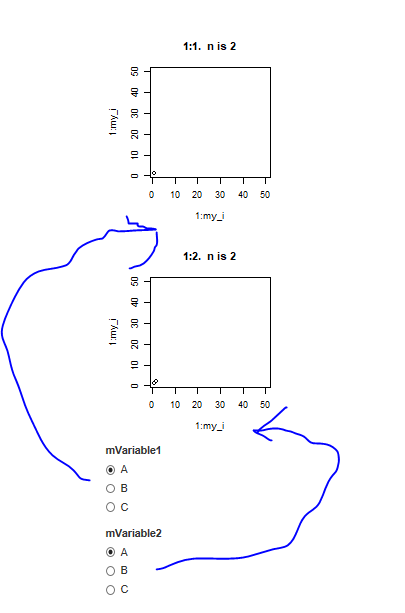I am new to the Shiny package with R. I want to plot a dynamic number of plots and be able to control each one of them individually based on the user input for each plot. This means that it will have a set of input that will dynamically pop up for each plot.
I know from this code here that one can dynamically add plots. From the code mentioned here, I was able to dynamically generate the inputs too. However, I cannot place them side by side.
When I try to do for two plots, I get the following. What I want is shown using the arrows:
Could you help me with this? My code is as below
server.R
max_plots <- 50
shinyServer(function(input, output) {
# Insert the right number of plot output objects into the web page
output$plots <- renderUI({
# radioButtons(inputId = paste0("mVariable",i), label = paste0("mVariable",i), choices = c("A","B","C"))
plot_output_list <- lapply(1:input$n, function(i) {
plotname <- paste("plot", i, sep="")
plotOutput(plotname, height = 280, width = 250)
})
# Convert the list to a tagList - this is necessary for the list of items
# to display properly.
do.call(tagList, plot_output_list)
})
output$Dynamic <- renderUI({
dynamic_selection_list <- lapply(1:input$n, function(i) {
radioButtons(inputId = paste0("mVariable",i), label = paste0("mVariable",i), choices = c("A","B","C"))
})
do.call(tagList, dynamic_selection_list)
})
# Call renderPlot for each one. Plots are only actually generated when they
# are visible on the web page.
for (i in 1:max_plots) {
# Need local so that each item gets its own number. Without it, the value
# of i in the renderPlot() will be the same across all instances, because
# of when the expression is evaluated.
local({
my_i <- i
plotname <- paste("plot", my_i, sep="")
output[[plotname]] <- renderPlot({
plot(1:my_i, 1:my_i,
xlim = c(1, max_plots),
ylim = c(1, max_plots),
main = paste("1:", my_i, ". n is ", input$n, sep = "")
)
})
})
}
})
ui.R
shinyUI(pageWithSidebar(
headerPanel("Dynamic number of plots"),
sidebarPanel(
sliderInput("n", "Number of plots", value=1, min=1, max=5)
),
mainPanel(
# This is the dynamic UI for the plots
uiOutput("plots"),
uiOutput("Dynamic")
)
))
